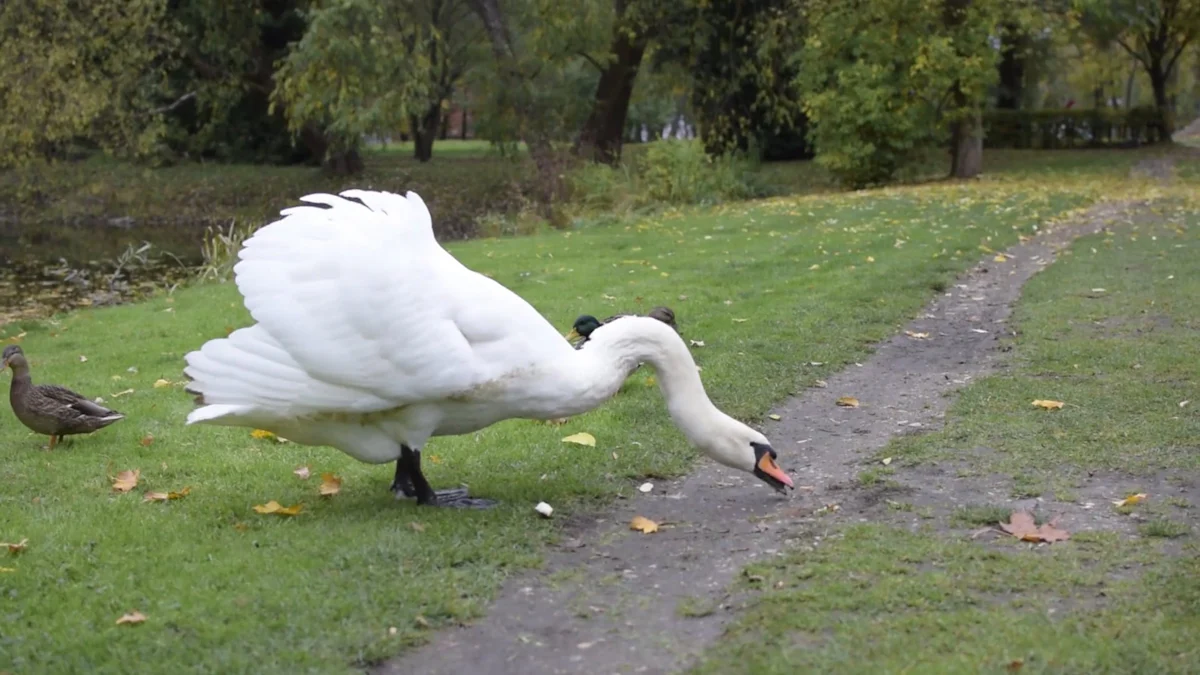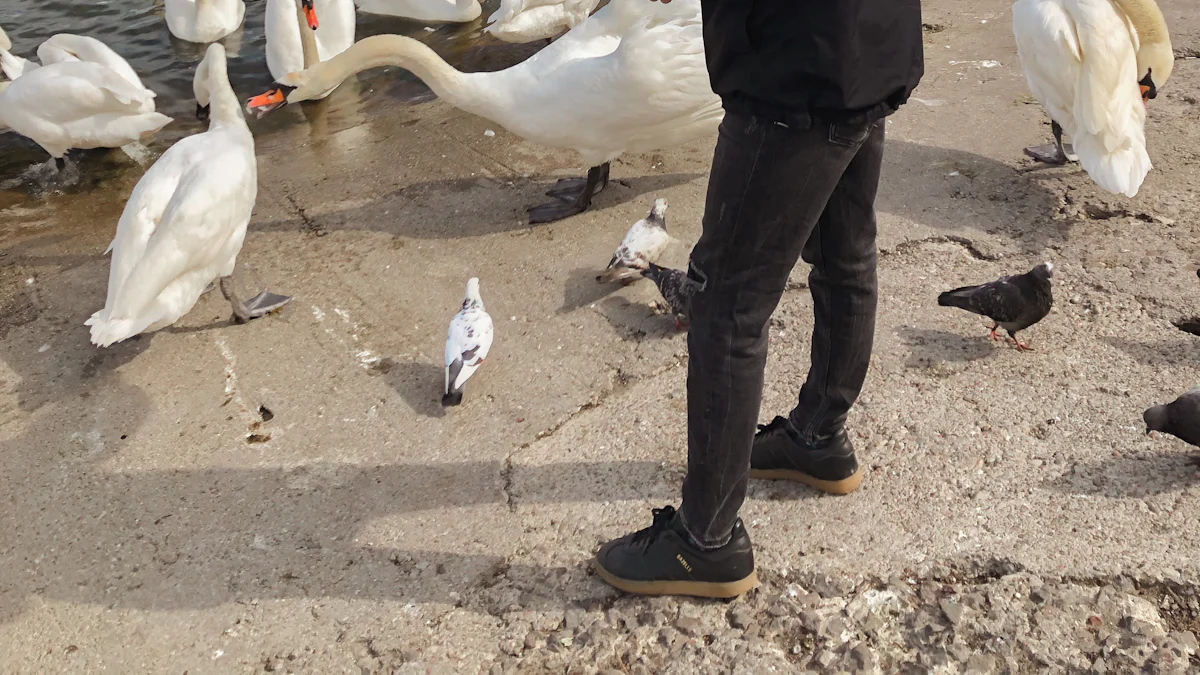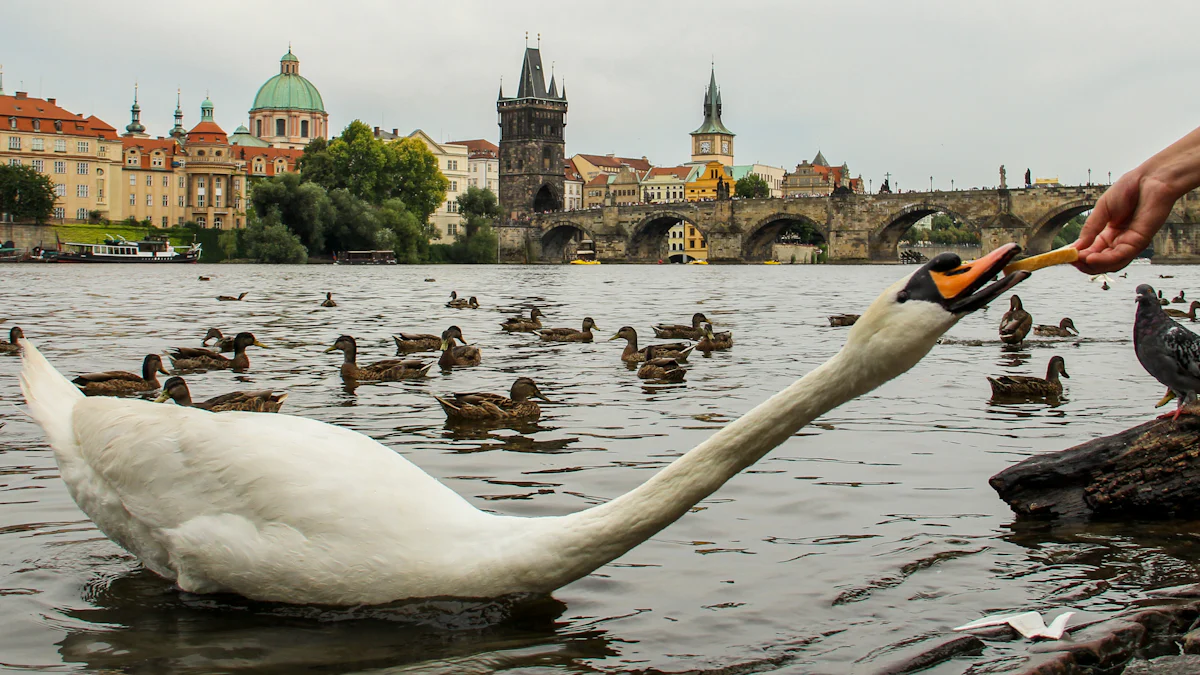
Picture swans gliding gracefully across serene lakes and wetlands. These elegant birds thrive on aquatic plants, algae, small water creatures, and grasses along the shore. Adding mealworms to their diet can boost their health. Swans mealworms are packed with protein and nutrients, supporting strong feathers, healthy skin, and overall vitality.
Key Takeaways
- Mealworms are a nutritious treat for swans, packed with protein and essential nutrients that support their health, feathers, and immune system.
- Feeding swans mealworms should be done in moderation—limit portions to a handful per swan and frequency to once or twice a week to maintain their natural foraging habits.
- Always ensure mealworms are fresh and clean before feeding, and consider soaking dried mealworms to make them easier for swans to digest.
Benefits of Feeding Swans Mealworms

Nutritional Value of Mealworms
Mealworms are tiny powerhouses of nutrition. They’re rich in protein, which helps swans build strong muscles and maintain their energy levels. These little insects also contain healthy fats, vitamins, and minerals like potassium and iron. All of these nutrients contribute to a swan’s overall health. When you add mealworms to their diet, you’re giving them a boost that supports their natural growth and vitality.
Another great thing about mealworms is their sustainability. They’re an eco-friendly food source that’s easy to produce. By feeding swans mealworms, you’re not only helping the birds but also making an environmentally conscious choice.
How Mealworms Support Swans’ Health
Swans rely on a balanced diet to stay healthy, and mealworms can play a big role in that. The protein in mealworms strengthens their feathers, making them more durable and water-resistant. This is especially important for swans, as they spend so much time in the water.
Mealworms also support healthy skin, which is crucial for swans to maintain their natural beauty. Plus, the nutrients in mealworms can improve their immune system, helping them fight off illnesses. Whether you’re feeding swans in a park or a conservation area, mealworms are a great way to keep them thriving.
Why Swans Are Attracted to Mealworms
Swans are naturally curious and love exploring new food sources. Mealworms mimic some of the small creatures they’d find in the wild, like insects and larvae. Their wriggly movement (if you’re using live mealworms) or their crunchy texture (if dried) makes them irresistible to swans.
When you toss mealworms into the water, you’ll notice how quickly swans flock to them. It’s a treat they enjoy, and it adds variety to their diet. By offering swans mealworms, you’re giving them a taste of something they’d naturally seek out in their environment.
How to Feed Swans Mealworms

Choosing Between Live and Dried Mealworms
When deciding between live and dried mealworms, you should consider the swans’ preferences and the feeding environment. Live mealworms wiggle, which can make them more appealing to swans. They mimic the movement of natural prey, making the feeding experience more engaging. However, live mealworms require proper storage and handling to ensure they stay fresh and safe.
Dried mealworms, on the other hand, are convenient and easy to store. They don’t spoil as quickly and are less messy to handle. If you choose dried mealworms, soak them in water before feeding. This makes them softer and easier for swans to digest. Both options can work well, but your choice depends on what’s practical for you and enjoyable for the swans.
Recommended Portion Sizes for Swans
Portion control is key when feeding swans mealworms. A handful of mealworms per swan is usually enough. Overfeeding can lead to health issues and disrupt their natural diet. If you’re feeding swans in a park or conservation area, limit the frequency to once or twice a week. This ensures they still forage for their usual food sources. Remember, mealworms should be a treat, not a staple in their diet.
Tips for Safe and Effective Feeding
To feed swans mealworms safely, follow these tips:
- Avoid feeding mealworms to cygnets (young swans). Recent guidelines suggest this due to safety concerns.
- Always check that the mealworms are fresh and clean. Spoiled mealworms can harm the swans.
- Scatter the mealworms in shallow water or on the ground. This mimics their natural foraging behavior and prevents overcrowding.
- Keep feeding sessions short and avoid creating dependency. Swans should still rely on their natural diet for most of their nutrition.
By following these steps, you can ensure that feeding swans mealworms is both safe and enjoyable for them.
Risks and Considerations
Avoiding Overfeeding
Feeding swans mealworms can be a delightful experience, but it’s important to avoid overfeeding. Too many mealworms can upset their natural diet and lead to health problems. Swans need a variety of foods to stay healthy, and relying too much on one treat can throw off that balance. You should think of mealworms as a special snack, not their main meal. Stick to small portions, like a handful per swan, and limit feeding to once or twice a week. This way, you’re helping them enjoy the benefits of mealworms without causing harm.
Ensuring Mealworms Are Fresh and Clean
Fresh and clean mealworms are essential for the swans’ safety. Spoiled or contaminated mealworms can make them sick. If you’re using live mealworms, check that they’re active and healthy before feeding. For dried mealworms, inspect the packaging for any signs of mold or damage. Soaking dried mealworms in water before feeding can also make them easier to digest. By taking these steps, you’re ensuring that the swans get a safe and nutritious treat.
Preventing Dependency on Human Feeding
Swans are skilled foragers and thrive when they find food on their own. Feeding them too often can make them dependent on humans, which isn’t good for their long-term well-being. You want to encourage their natural behaviors, not replace them. When you feed swans mealworms, keep the sessions short and occasional. This helps them maintain their independence while still enjoying a tasty treat.
Alternatives to Swans Mealworms
Other Healthy Treats for Swans
If you’re looking for other treats to feed swans, there are plenty of options that are both safe and nutritious. Swans enjoy leafy greens like lettuce, spinach, and kale. These mimic the aquatic plants they naturally eat. You can also offer grains such as oats, barley, or wheat. Just make sure they’re plain and not processed.
Vegetables like peas and corn are another great choice. They’re easy for swans to eat and provide essential nutrients. If you want to give them fruit, stick to small pieces of apples (without seeds) or grapes. These add a touch of sweetness to their diet. Always remember to keep portions small and avoid seasoning or additives.
Foods That Should Be Avoided
Not all foods are safe for swans. Some can even be toxic. Here’s a quick list of what to avoid:
- Chocolate: Causes digestive issues and seizures.
- Salt: Leads to dehydration and kidney problems.
- Apple Seeds: Contain cyanide; remove them before feeding.
- Onions: Can cause anemia and digestive trouble.
- Dried Beans: Contain toxins harmful to birds.
- Avocados: May cause heart issues.
- Mushrooms: Some types can damage their liver.
- Caffeine and Alcohol: Disrupt heart function.
- Tomato Leaves: Highly poisonous to birds.
Stick to natural, swan-friendly foods to keep them healthy and safe.
Encouraging Natural Foraging Habits
Swans are natural foragers. They thrive when they search for food on their own. You can help them maintain this behavior by feeding them sparingly. Swans naturally eat aquatic plants, grasses, and grains. In spring and summer, they enjoy fresh shoots and pondweeds. During winter, they graze on land for grass and seeds.
To encourage foraging, avoid feeding them too often. Let them explore their environment and find food naturally. This keeps them active and ensures they get a balanced diet. By supporting their natural habits, you’re helping swans stay independent and healthy.
Feeding swans mealworms is a simple way to support their health and happiness. These treats provide essential nutrients while mimicking the natural food they’d find in the wild. By feeding responsibly and offering variety, you help swans thrive. Remember, moderation is key to keeping them healthy and independent.
FAQ
Can you feed mealworms to other birds like geese or ducks?
Yes! Geese and ducks also enjoy mealworms. These treats provide similar health benefits, supporting their feathers, skin, and overall growth.
Should you soak dried mealworms before feeding them?
Soaking dried mealworms softens them, making them easier for swans to digest. It’s a quick step that ensures their comfort and safety.
How often should you feed swans mealworms?
Limit feeding to once or twice a week. This keeps their diet balanced and prevents dependency on human-provided food.


